Last November, longtime Mac vendor OWC was among the first wave of companies to announce Thunderbolt 3 docks designed to expand the capabilities of the new MacBook Pro. Product design, testing, and manufacturing took some time to finalize, but OWC’s Thunderbolt 3 Dock is almost ready to ship, and we’ve had the chance to spend some time with a production-ready unit.
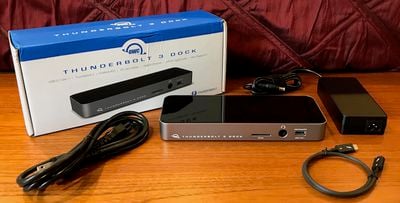
Priced at $299, OWC’s Thunderbolt 3 Dock features an array of 13 ports that let you connect a number of devices to your MacBook Pro. It all comes in a package measuring about 9 inches by 3.5 inches and an inch thick, surrounded by brushed aluminum and glossy black plastic on top and bottom.
The design is relatively unobtrusive, although the OWC logo and “Thunderbolt 3 Dock” text on the front are fairly prominent. The dock is powered by a decently large external power brick, which reduces the dock’s size but also means you have one more tool to juggle all your other cords with.
As for the functional aspects of the dock, OWC chose to put three frequently used ports on the front: an SD card reader, a combo audio in/out port for headphones and microphones, and a USB-A 3.1 Gen 1 port that delivers up to 1.5 amps of current. It’s a handy set of ports that require regular access for connecting and disconnecting peripherals or swapping out memory cards.
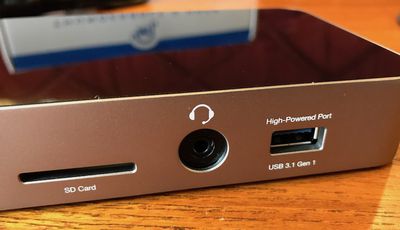

The back of the dock has ten more ports and DC power input from the external brick. There are four more USB-A 3.1 Gen 1 ports, one of which is another 1.5A high-power port while the other three offer the standard 0.9A of current. Also included is an S/PDIF digital audio output port, a FireWire 800 port, and a Gigabit Ethernet port.
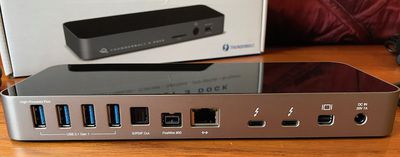

Next are a pair of Thunderbolt 3 ports, one of which is used to connect to your MacBook Pro and the other can be used to connect a Thunderbolt 3/USB-C display and/or additional Thunderbolt devices. Adapters can also be used to connect devices with other connectors. Finally, there’s a Mini DisplayPort to support additional displays.
Launching
There is no power switch on the Thunderbolt 3 dock, so as soon as you plug in the power brick and connect to the dock, the unit turns on and a blue light on the dock lights up. Similarly, once you connect the dock to a computer, a green light flashes to indicate that the dock has an active data connection.
The blue and green LEDs are actually located on the bottom of the dock and therefore are only visible as reflections of the desk or other surface under the dock, as the dock is slightly elevated on small feet. The design makes it a little difficult to see if the lights, especially the green light, are on unless you’re in a dim environment. In day-to-day use, however, things should just work and you won’t need light, so putting them down is unobtrusive.
Data transfer
I connected a USB 3.0 external hard drive to the dock and saw read and write speeds close to 100 MB/s, which isn’t the fastest connection but will probably be fine for many users. If you need faster speeds, you’ll want to use a drive with the latest USB 3.1 Gen 2 standard and connect it directly to your MacBook Pro.
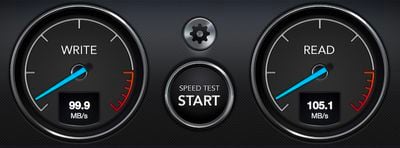

I don’t usually use wired networking in my home, but I was able to maximize my 200/20 Internet connection by connecting my MacBook Pro to my Airport Time Capsule through the dock’s Ethernet port. The Ethernet connection was recognized seamlessly by my Mac from the dock.
Display support
In line with Thunderbolt 3’s capabilities, OWC says its dock can support a single 5K display or two 4K displays. I connected an LG Ultrafine 5K display via the dock and had no problem running the display and the dock’s hub capabilities simultaneously via one cable.
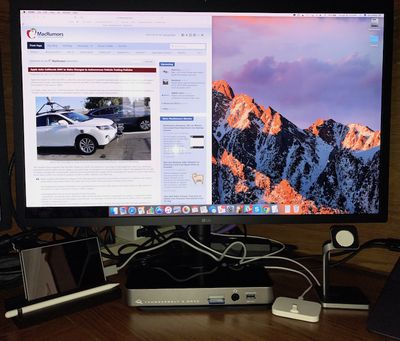

OWC is still testing different configurations, but you’ll be able to connect two 4K displays through the dock, one through the Thunderbolt 3 port (possibly with an adapter) and one through Mini DisplayPort.
charging capacity
With the dock using the Thunderbolt 3/USB-C standard, it can deliver power to your MacBook Pro through the same cable used for data, although the dock only supports up to 60 watts. That’s enough for a 13-inch MacBook Pro, but the 15-inch model can draw up to 85 watts, so it will charge more slowly through the dock than its power adapter or even continue to drain, depending on the load.
On the USB-A side, the high-capacity 1.5A ports are helpful for charging devices faster than a standard USB port or iPhone adapter, but don’t quite match the 2.1A or 2.4A you’d get from an iPad power adapter. .
Tidbits
I’m not sure if it’s something unique to my unit or my setup, or if it’s a common problem, but the dock I’ve got is a quiet high-pitched hissing depending on what else I have on and connected to my MacBook Pro. Connected to the dock by sound. It’s not terribly annoying and I’m sure it’s something I can get used to, but I did notice it and so it’s something to be aware of if you’re sensitive to that sort of thing.
Interestingly, inserting an SD card into the dock stops the noise, so a possible solution for those experiencing the problem could be to keep a card in the slot at all times. Likewise, connecting a display to a second Thunderbolt 3 port also turns off noise.
OWC includes a Thunderbolt 3 cable with the dock, but it’s only a 0.5-meter cable. On the potential downside, this limits how far you can place the dock from your computer, especially if you want to place the dock on the left side of your computer, and most of the cable length reaches the back of the dock. . On the plus side, if you want to keep the dock close to your MacBook Pro, you won’t need extra cables to deal with on your desk.
wrap up
At $299, OWC’s Thunderbolt 3 dock is a significant investment, but it’s not quite on par with other full-featured Thunderbolt 3 docks that will soon hit the market. It offers a variety of ports for maximum compatibility, a major plus for those affected by Apple’s decision to only include Thunderbolt 3/USB-C ports on the MacBook Pro. This makes it easy to connect everything to your desk with just one cable so you can quickly pick up your computer and go.
Support for the latest USB 3.1 Gen 2 speeds would be welcome, but when you’re potentially saturating the Thunderbolt 3 connection with displays and other accessories, it’s probably understandable that not everything can run at maximum speed.
OWC is still awaiting official Thunderbolt 3 certification from Intel and Apple, and so a firmware update may be required to bring these pre-certified review units to final shipping versions, but OWC is confident it will receive the necessary certification and current advance units reflect final retail unit performance. will be
Due to pending certification, OWC cannot yet commit to a specific launch date The units are otherwise ready to go, so once Intel approves and any final firmware changes are made, OWC will be able to start shipping and we’ll keep you updated on that progress.
Update: OWC tells us that they have identified the source of the hissing sound and are working on a solution
Update May 18: OWC tells us that a resolution for the hissing sound has been implemented and will be included in all shipping units.
We have had some reports/observations that the dock emits a very faint sound under certain conditions. The component responsible for this has been identified and a solution has been implemented that mitigates the problem. All retail, production units shipped will incorporate this implementation and will not be subject to these emissions.
Also note, if you have a unit that has observed this sound – it is not a cause for concern, it is not a defect or faulty component. Even the noise should be exceptionally low decibels and noise monitoring is outside the scope of normal dock use. Although we have taken steps to eliminate this, it has been done to clear up misunderstandings.
Note: OWC provided the Thunderbolt 3 Dock to MacRumors free of charge for the purpose of this review. No other compensation was received.
